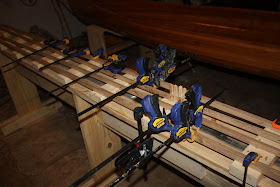The next step was to install the decks of the canoe. Because of the moderate recurve of the canoe which is the area exposed to the wind, the longer decks were not conducive to the the canoe's current shape, so i had to cut down the canoe's recurve to fit the deck. After mixing up some epoxy, I put placed it on the place where the decks were going and tried to screw them in with brass screws. Yet, because of the strength of the white oak, I had to use steel screws. The decks had to be installed first, before the gunwales, which was the next piece to be installed.
Friday, April 19, 2013
Building the Decks

The decks on the cedar strip canoe are probably the most versatile aspect of the canoe. The decks differ in length, type of wood, coaming, and end design. My decks were made out of white oak so it would compliment the white oak of the gunwales. 20 in. in length by 11 in. at the width by 3/4in. thickness, the dimensions of wood were to big to be made with one piece of wood. I decided to make the decks at the bow and stern the same dimensions to ease the construction process. Also, I decided to make the decks longer so I could hide the rough sanded and glue globs at the stems. Since the wood was only 6 1/2 in. wide, I cut the wood with a table saw at a diagonal so I would be able to achieve the desired width. After the wood was cut on the table saw it was not perfectly straight, so I planed it flush. At this point, I did not care about cutting off the point at the triangle to fit in to the canoe but more cared about whether the sides were correct. To enable strength with the butt joint, a splice was made and a place for it was cut on the table saw so the two pieces could fit together and combine to make a bigger piece of wood. When the glue dried, I wanted to ensure that they would not break so I drilled a piece of white oak underneath. After the triangle decks were made, a curve on the bottom was cut with a band saw to help with the consistency of the curves of the canoe. After the decks were made, the next step was to install them.
Wednesday, April 17, 2013
Building the Gunwales Part II
 The second step of building the inwale was to make the scuppers. The scuppers are helpful in to ways: they enable the water to drain out of the canoe when flipped over and they allow gear to be tied down. Scupper lengths vary from an inch to multiple inches. My scuppers were 3 1/2" long and were spaced 3 1/2" away from each other. The scuppers were not only cut on the chop saw but also routed to give them a curved edge, which would complement the whole curviness of the canoe. They were then glued onto the inwale outer strip at the correct spacing and then clamped down with multiple binder clips from Staples. After the glue dried, it was sanded with a belt sander to ensure a smooth surface. Then finally the next step was to build the deck.
The second step of building the inwale was to make the scuppers. The scuppers are helpful in to ways: they enable the water to drain out of the canoe when flipped over and they allow gear to be tied down. Scupper lengths vary from an inch to multiple inches. My scuppers were 3 1/2" long and were spaced 3 1/2" away from each other. The scuppers were not only cut on the chop saw but also routed to give them a curved edge, which would complement the whole curviness of the canoe. They were then glued onto the inwale outer strip at the correct spacing and then clamped down with multiple binder clips from Staples. After the glue dried, it was sanded with a belt sander to ensure a smooth surface. Then finally the next step was to build the deck.Building the Gunwales Part I
The first step after the interior was sanded was actually not building the decks but was constructing the gunwales (gunnels). Even though, the decks were the first piece to be installed, I built the gunwales first. Because my white oak board was only ten feet long, I had to scarf the pieces together. The outwale or (outer gunwale) was only a strip of white oak 3/4" x roughly 3/4". The inwale (inner gunwale) was 3/4" thick yet was slightly different than the outwale. There were two components to the inwale: the outside strip and the scupper. The long strip was 3/8" thick as well as the scupper. The next blog post will show the assembly of the inwale, since the outwale construction was very basic.
Sanding the Fiberglass (Interior)
Sanding the fiberglass on the interior was much more difficult than sanding the exterior. Because of the tumblehome of the canoe, the curve was hard to sand with the orbital sander. Also, while applying the epoxy to the inside, the epoxy wanted to run because gravity was forcing down. Near the bow and stern stem piece the epoxy began to pool, so I used a sander extension on the dremmel to make it smooth. Sadly, while applying filler coats of epoxy, some epoxy got on the outside of the canoe which had to be sanded off. Sanding with 80, 120, and 220 grit, the interior of the canoe is finished except for a last sanding and then varnishing. Some canoe manufactures even used to sell canoes this way (without trim and detailed interior). The next step was to work on the two decks at the bow and stern.










